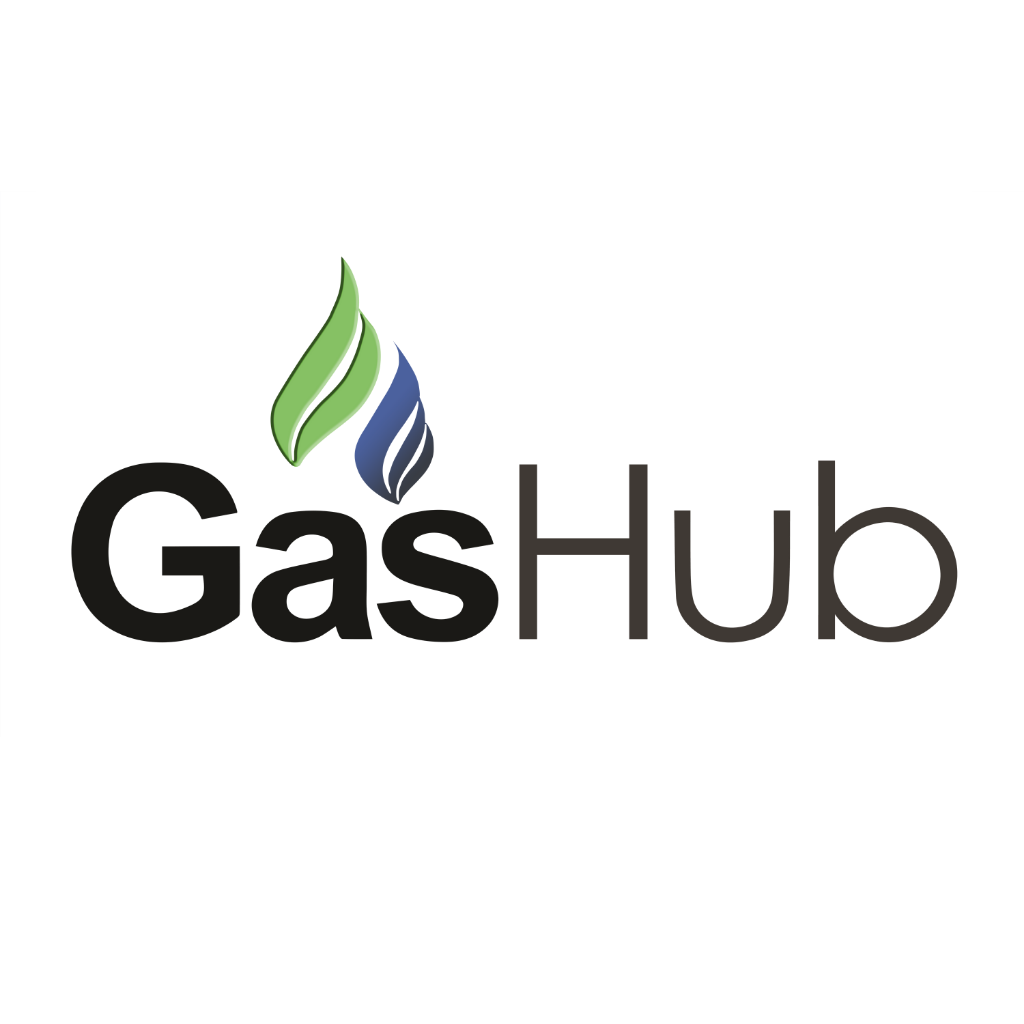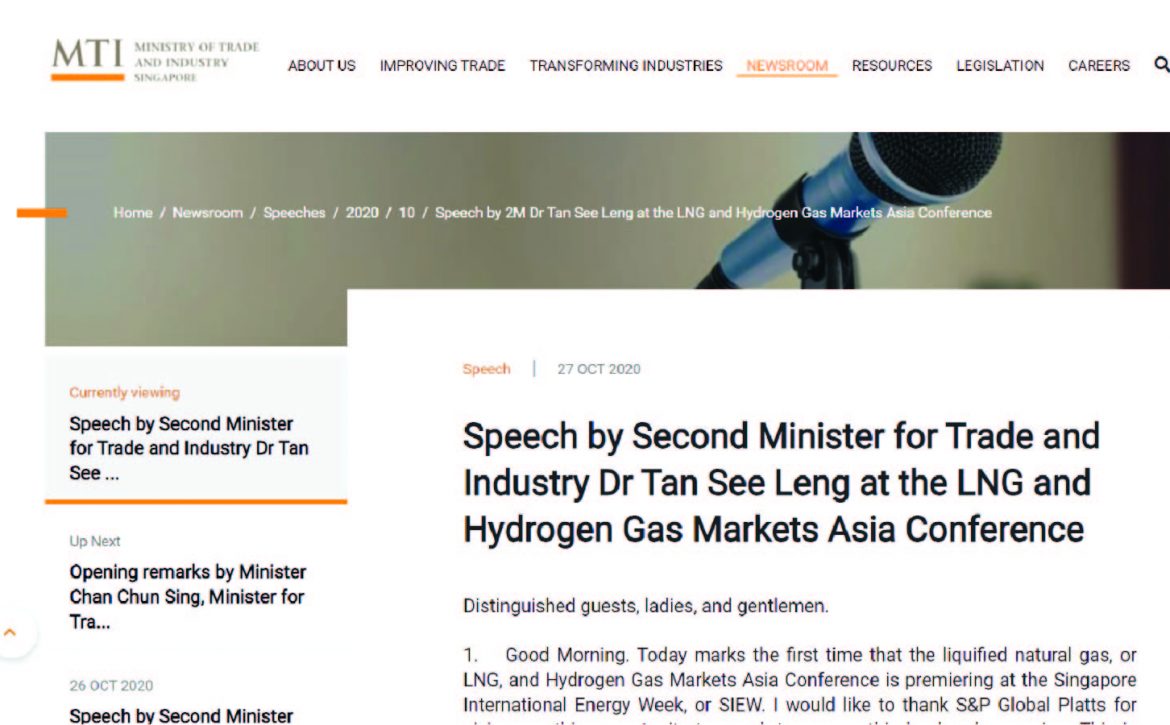Speech by Second Minister for Trade and Industry Dr Tan See Leng at the LNG and Hydrogen Gas Markets Asia Conference
Distinguished guests, ladies, and gentlemen.
1. Good Morning. Today marks the first time that the liquified natural gas, or LNG, and Hydrogen Gas Markets Asia Conference is premiering at the Singapore International Energy Week, or SIEW. I would like to thank S&P Global Platts for giving me this opportunity to speak to you on this landmark occasion. This is especially considering that this is also my first time at SIEW, and I am very happy to be able to join you today.
The Role of LNG in Singapore
2. I would first like to speak on the role of LNG in Singapore, and it is timely that we highlight LNG’s viability as a key fuel source. Climate change is one of the greatest challenges we will face for generations to come, and one that has sparked a strong interest in the use of LNG, as the cleanest fossil fuel, for energy production. Countries seeking to lower their carbon emissions have increasingly shifted towards using LNG, instead of coal, as their primary fuel of choice.
3. A report by the International Energy Agency, or IEA, noted that, over the last decade, natural gas contributed to one-third of total energy demand growth worldwide, more than any other fuel. Today, it accounts for 23% of global primary energy demand, and nearly a quarter of total global electricity generation. Notably, countries in the Asia Pacific will account for over half of incremental global gas consumption in the coming years. LNG is especially attractive for countries that face constraints in deploying renewables due to limitations in geography, size and a lack of hydro or geothermal resources. This is in addition to its lower carbon emissions relative to other fuels. In short, there is a strong desire for more secure, affordable and clean fuels.
4. Singapore too, shares this desire. At last year’s SIEW, Minister Chan Chun Sing announced Singapore’s Energy Story – our plan for securing our energy needs. Anchoring the Energy Story are the “Four Switches,” namely, Natural Gas, Solar, Regional Power Grids, and Low Carbon Alternatives. As one of the “Four Switches,” natural gas has been a key element of our energy mix over the last two decades, and having transformed Singapore’s energy landscape thus far, it will continue to power Singapore’s future.
5. In fact, the growth in demand for LNG in Singapore mirrors the increase in global demand for LNG over the years.In 2001, when we first began using natural gas as an energy source for electricity generation, it made up 26% of our energy mix. Today, that figure has risen to 95%.
6. Yet it is only more recently, with the liberalisation of Singapore’s energy market and the commencement of operations of the LNG terminal in 2013, that we have been able to tap on LNG on such a large scale. Since then, LNG has played a progressively bigger role in electricity generation and other industry needs.This is exemplified by how many power generation companies started using more efficient gas turbines, and how refineries and petrochemical companies have switched to LNG for their operations.
7. Even as Singapore shifts towards other cleaner energy sources, LNG will continue to be a substantial part of our energy mix in the near future. Therefore, to support our power generation companies’ bid to improve energy efficiency and reduce carbon emissions, the Energy Market Authority, or EMA, will be awarding $23 million to Tuas Power, Senoko and YTL PowerSeraya under its inaugural Genco Energy Efficiency Grant Call, with a second run of this Grant Call to be launched in January next year. This is just one aspect of three key areas we are working on to achieve our aspirations of a cleaner and more efficient energy future:
• One, diversifying our LNG sources;
• Two, empowering our industry players; and
• Three, exploring new energy solutions.
Diversifying our LNG sources
8. First, we will continue maintaining a diversified portfolio of LNG sources.This will enhance our flexibility and access to reliable sources, and improve price competitiveness in Singapore’s gas market.
9. To this end, EMA has issued a Request-for-Proposal in July 2020, to appoint up to two new LNG term importers by the first quarter of 2021.This will increase the number of LNG importers in our ecosystem, allowing gas buyers to have more options to procure gas at better terms and more competitive prices.
Empower our industry players to capture new growth opportunities
10. Second, we will build up our capabilities and infrastructure to empower our industry players to capitalise on growth opportunities.
11. According to IEA’s Gas 2020 report, global demand for natural gas is forecasted to grow by 1.5% annually from 2021 to 2025. Singapore, as the main oil trading hub in Asia, is seen as a natural hub for LNG. However, this perception is not something we can take for granted. To establish ourselves as the hub for LNG in Asia as well, we will continue working closely with industry players to ensure that we can capture these growth opportunities.
12. One major development in our LNG industry was the launch of EMA’s Expression of Interest in November last year for private companies to build, own and operate an offshore LNG Terminal in Singapore. The terminal will enhance Singapore’s value proposition as a LNG hub by increasing LNG trade flows in the region and providing services that support growing segments in the LNG market, such as bulk-breaking and bunkering. I am happy to note that the Expression of Interest was well-received, and EMA is currently developing a regulatory framework to facilitate the entry of such infrastructure.
13. This is but one component of “the bigger picture” we aim to achieve.The “bigger picture” is to develop a comprehensive and trusted ecosystem of LNG-related services and infrastructure solution providers.Today, our strategic location in this fast-growing region, pro-enterprise policies and strong support from our financial and legal sectors has seen more than 50 LNG trading or business development companies establishing a presence in Singapore. As we strengthen our LNG trading ecosystem, I am confident that this number will continue to grow, cementing our status as an appealing destination for gas companies and professionals looking to expand their presence here.
Explore new energy solutions
14. Last but not least, we will explore new energy solutions to meet both our long-term energy needs and low-emissions targets.
15. Singapore is committed to the global fight against climate change. Our aim is to first halve our peak carbon emissions to 33 million tonnes of carbon dioxide equivalent by 2050, and subsequently achieve net zero emissions as soon as possible in the second half of the century. To achieve this, we must look at emerging technologies that have the potential for further decarbonisation while keeping energy affordable and reliable.
16. One field where such emerging and potentially game-changing technologies can be seen is in the use of hydrogen for electricity generation. Today, hydrogen is primarily used in industry, for processes such as oil refining and the production of fertilisers. With technological advancements, hydrogen has the potential for much wider usage through reducing carbon emissions in numerous applications across various sectors. As part of the “Four Switches” of the Energy Story, under Low Carbon
Alternatives, Singapore is studying how hydrogen can be feasible for us.
17. For example, today, natural gas is burnt in combined cycle gas turbines to generate electricity. While natural gas is the cleanest fossil fuel, this process still generates carbon emissions. This is where hydrogen can play its game-changing role. Turbine manufacturers are now developing gas turbines that can burn pure hydrogen for electricity generation – a process that emits no carbon emissions. Using such hydrogen gas turbines would see a significant reduction in carbon emissions in our energy mix.
18. However, there are three major challenges we must first overcome:
• First, global supply chains for hydrogen need to be established;
• Second, extensive infrastructure for hydrogen import, storage, transport and end-use need to be put in place; and
• Thirdly, the current price of producing and importing hydrogen is high, making wider adoption difficult.
19. The Singapore Government still sees hydrogen as an important energy solution, and we have taken three initial steps to overcome current challenges, and understand and chart the role that hydrogen can play in our future energy landscape. First, to assess the feasibility of hydrogen in reducing longer-term emissions, various government agencies commissioned a joint study on hydrogen imports and downstream applications in Singapore last year. This study will cover potential sources of hydrogen imports based on availability, cost, technical feasibility and supply security up to 2050;
20. Second, Minister Chan announced just yesterday that the Government will devote funds to support our local research community to develop and test-bed promising low-carbon energy technologies, including hydrogen technologies; and
21. Last but not least, we are strengthening our partnerships with international bodies and other countries to keep pace with global technological developments, and to work together on practical projects to develop hydrogen markets, supply chains and standards. For example:
• Yesterday, Singapore signed a Memorandum of Understanding, or MOU, with Australia to drive cooperation on low-emissions solutions including hydrogen.
• Singapore is also working with other like-minded partners, such as Chile, to conclude a MOU to study the R&D, application, supply chain and standard setting for the deployment of hydrogen.
22. However, none of this would have been possible without our local industries, and we are greatly heartened by their efforts. Let me list two examples:
• First, in March this year, five Singapore companies signed a MOU with two Japanese companies, Chiyoda Corporation and its main shareholder, Mitsubishi Corporation, to develop ways of utilising hydrogen as a green energy source.
• Second, in 2019, Singapore’s energy utilities company, SP Group, launched a concept lab that uses solar power to produce hydrogen, which can in turn produce electricity when needed.
These are but a snapshot of efforts across the industry, and we look forward to more industry-led partnerships on various low-carbon hydrogen pathways in the future.
Conclusion
23. In conclusion, energy – and the fuel sources used to generate it – form the bedrocks of an economy and powers it forward. LNG has proven to be such a bedrock. For the present and the foreseeable future, it will not only continue to play a substantial role in Singapore’s energy mix, it will also help the world address the challenges of climate change. For the further, but not-too-distant future, advancements in technology will increasingly see hydrogen become a key energy resource. It too could become a bedrock of our economy by helping us meet climate change goals and needs.
24. However, to harness these resources, industries, organisations, and governments have to work together to plan and implement new strategies to ensure that today’s needs are met whilst addressing tomorrow’s challenges. I am glad that we have thus far proven ourselves up to this task, and I would like to encourage everyone here today to continue looking forward to achieve our goals. In this regard, Singapore stands ready to work with like-minded partners from around the world, and I hope that today’s conference would be the start of many more partnerships that will enable us to create a brighter, low carbon energy future together. On this note, I wish you a fruitful and productive conference. Thank you.

